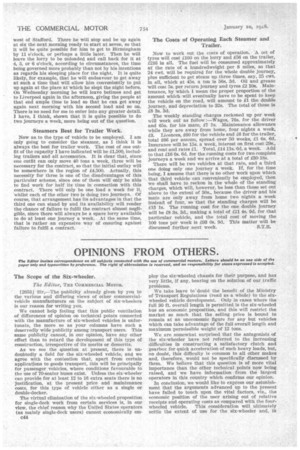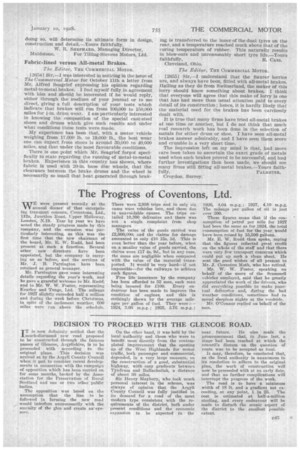OPINIONS FROM OTHERS.
Page 66

Page 67

If you've noticed an error in this article please click here to report it so we can fix it.
The Editor in correspondence on all subjects connected with the use of commercial motors. Letters should be on one side of the
paper only and typewritten by preference. The right of abbreviation is reserved, and no responsibility for views expressed is accepted.
The Scope of the Six-wheeler.
The Editor, TEE COMMERCIAL MOTOR.
[26531 Sir,.----The publicity already given by you to the various and differing views of other commercialvehicle manufacturers on the subject of six-wheelers is our reason for writing you.
We cannot help feeling that this public ventilation of differences of opinion on technical points connected with the manufacture of six-wheeled vehicles is unfortunate, the more so as your columns have such a deservedly wide publicity among transport users. This same publicity cannot, in our opinion, have any other effect than to retard the development of this type of construction, irrespective of its merits or demerits.
As we see the question at present, there is undoubtedly a field for the six-wheeled vehicle, and we agree with the contention that, apart from certain applications to goods transport, this will be principally for passenger vehicles, where conditions favourable to the use of 70-seater buses exist. Unless the six-wheeler can provide for at least 12 to 16 extra seats there is no justification, at the present price add maintenance costs, for this type of vehicle either as a single or double-decker.
The virtual elimination of the six-wheeled proposition for single-deck work from certain services is, in our view, the chief reason why the United States operators (as mainly single-deck users) cannot economically em c44 ploy the six-wheeled chassis for their purpose, and has very little, if any, bearing on the solution of our traffic problems.
We take leave to' doubt the benefit of the Ministry of Transport Regulations (read as a whole) to the sixwheeled vehicle development. Only in cases where the full 30 ft. overall length is permitted is the six-wheeled bus an economic proposition, and this will restrict the market so much that the selling price is bound to remain at an uneconomic figure for any but vehicles which can take advantage of the full overall length and maximum permissible weight of 12 tons.
We are somewhat surprised. that the antagonists of the six-wheeler have not referred to the increasing difficulties in constructing a satisfactory clutch and gearbox for quick acceleration of such heavy loads, but, no doubt, this difficulty is common to all other makes and, therefore, would not be specifically discussed by them. We believe that this question is of more vital importance than the other technical points now being raised, and we have information from the largest operators in this country which confirms our opinion.
In conclusion, we would like to express our astonishment that the arguments advanced up to the present have failed to touch upon the vital factors, viz., the economic position of the user arising out of relative receipts and operating costs as compared with the fourwheeled vehicle. This consideration will ultimately settle the extent of use for the six-wheeler and, in doing so, will determine its ultimate form in design, construction and detail.—Yours faithfully, W. R. SHEPHARD, Managing Director, Maidstone. For Tilling-Stevens Motors, Ltd.
Fabric-lined versus All-metal Brakes. .
The Editor, THE COMMERCIAL MOTOR.
126541 Sir,—I was interested in noticing in the issue of The Commercial Motor for October 11th a letter from Mr. Alfred Seagrief expressing his opinion regarding metal-to-metal brakes. I find myself fully in agreement with him anti should be interested if he would reply, either through the medium of your journal or to me direct, giving a full description of your tests which indicate that brakes will run from 100,000 to 150,000 miles for Fin. drum wear. I am particularly interested in knowing the composition of the special cast-steel shoes and drums which give such results and under what conditions these tests were made.
My experience has been that, with a motor vehicle weighing from 17,000 lb. to 19,000 lb., the best wear one can expect from shoes is around 30,000 to 40,000 miles, and that under the most favourable conditions.
There is one point which Mr. Seagrief forgot specifically to state regarding the running of metal-to-metal brakes. Experience in this country has shown, where fabric is used with 20-in, base disc wheels, that the clearance between the brake drums and the wheel is necessarily so small that heat generated through brak
ing is transferred to the inner of the dual tyres on the rear, and a temperature reached much above that of the curing temperature of rubber. This naturally results in blow-outs and unreasonably short tyre life.—Yours
faithfully, R. CASS. Cleveland, Ohio.
The Editor, THE COMMERCIAL MOTOR.
[2655] Sir,—I understand that the Saurer lorries are, and always have been, fitted with all-metal brakes. Hailing as they do from Switzerland, the maker of this lorry should know something about brakes. I think that everyone will agree that this make of lorry is one that has had more than usual attention paid to every detail of its construction ; hence, it is hardly likely that the material used for the brakes has been carelessly dealt with.
It is true that many firms have tried ail-metal brakes at one time or another, but I do not think that much real research work has been done in the selection of metals for either drum or shoe. I have seen all-metal brakes answer admirably, and I have seen them score and crumble in a very short time.
The impression left on my mind is that, had more care been taken to ascertain the exact: grade of metals used when such brakes proved to be successful, and had further investigations then been made, we should see many firms still fitting all-metal brakes.—Yours faith fully, PALMETER. Croydon, Surrey.'












































































































